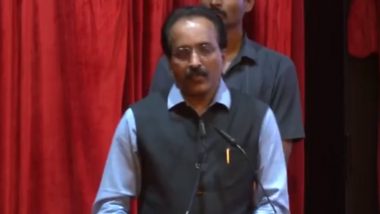Mumbai, Dec 28: Aditya L1, the Indian Space Research Organisation's solar mission, will reach the Lagrange point 1 (L1) of the Sun-Earth system on January 6, which will enable the spacecraft to view the sun without any eclipses, ISRO chief S Somanath said on Thursday. The mission was launched in September this year.
"Aditya L1 is almost there now. Aditya L1 will reach Lagrange point on January 6 at 4 pm. We will have a very controlled burn of the engine of Aditya L1 so that it enters an orbit called the halo orbit," Somanath said at Techfest 2023, the Indian Institute of Technology Bombay's annual science and technology event. Lagrange point is a region where gravity between earth and sun will neutralise. India’s Achievements in Space Sector in 2023: From Historic Chandrayaan-3 Moon Landing to Aditya L1 Mission Launch and Plan for Space Station, How ISRO Made Indians Proud.
Absolute neutralisation is not possible because there are other bodies like the Moon, Mars, Venus, Somanath said. All six payloads have been tested and "working beautifully", he said, adding all are giving very good data.
"After the insertion the satellite will be destined to look at the Sun forever as long as its electronics inside are healthy and ready to transmit data. We hope to find out a lot of correlation between the solar corona and mass ejection and impact on space weather we are facing everyday," Somanath added.
On Chandrayaan-3, India's lunar mission, Somanath said after 14 days of its contribution of collecting data, the Pragyan rover is "sleeping very well" on the lunar surface. Aditya-L1 Mission Update: L1 Point Insertion of Aditya L1 Will Be Done on January 6, Says ISRO Chief S Somnath (Watch Video).
"It is sleeping forever in history. Unfortunately, we were hoping it would wake up, but it did not happen. When we tested the whole system in our laboratory, it was working," he said.
Somanath explained that some systems that worked in the laboratory may not work on the lunar surface due to various reasons like radiation.













 Quickly
Quickly




















